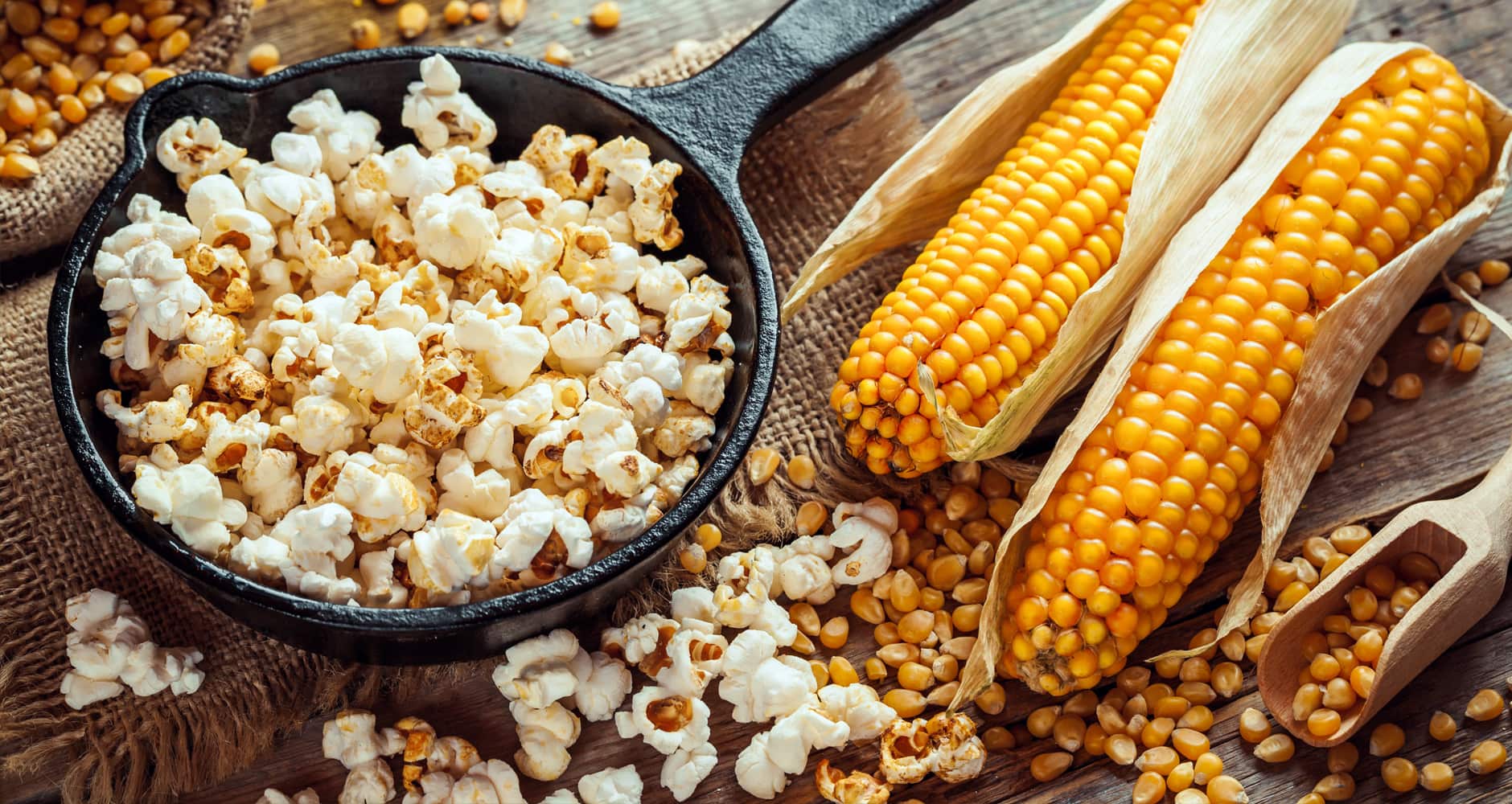 The majority of the popcorn grown and sold worldwide comes from the Midwest, in an area known as the Corn Belt of the United States.
The majority of the popcorn grown and sold worldwide comes from the Midwest, in an area known as the Corn Belt of the United States.
In the Midwest, the summers are long and hot, which allow enough time for growing the crop. The soil is deep and fertile and rich in organic material, providing plants with the needed nutrients to grow. The Midwest gets enough water through regular rainfall or with irrigation systems from nearby rivers, lakes, and wells. The flat land makes it easier when planting and harvesting crops.
Popcorn is a whole grain maize product. It resembles corn-on-the-cob in appearance and cultivation, although only popcorn kernels have the ability to pop.
Popcorn, like all six types of corn, is a cereal grain and originates from a wild grass. Its scientific name is Zea mays everta, and it is the only type of corn to actually pop.
Popcorn is made up of three main components: endosperm, germ and the pericarp (also known as hull or bran). The endosperm is made up of soft and hard starch granules. The endosperm is always white or yellow in color and is a carbohydrate. The function of the starch is to provide energy for the living part of the kernel, more commonly known as the “germ” or “embryo.” The outer hull of the kernel is the pericarp, which is made of cellulose. The pericarp or hull is usually white or yellow in color, though the range of colors includes red, black and many colors in between.
Growing Popcorn Kernels One acre of land uses almost 30,000 seeds. Once the plant is fully mature, the corn is picked and fed through a combine, removing the cob’s kernels. These kernels are dried in a special container, optimizing the moisture level for popping.

The Growth of a Popcorn Plant
Popcorn seed will germinate in approximately seven days and emerges from the soil in 10 days. It is the moisture in the soil, which dissolves important elements for the plant such as nitrogen, phosphate and potash. The popcorn roots absorb this nutrient rich moisture to “feed the seed and cause it to germinate. When the sun shines on the new leaves, the green chlorophyll in the leaf contains water, which is combined with the carbon dioxide in the air, creating sugar. The plant uses the sugar to build more leaves and roots, and eventually ears of popcorn. This process is called photosynthesis.
As the popcorn plant grows, the stalk will reach approximately eight feet in height and produce long, green leaves. Popcorn requires 18-24 inches of water during the growing season. As the plant grows, it begins to produce ears of corn, covered with a green husk. Feathery tassels form at the top of the plant and produce pollen, a yellowish powder. The ears form silks or long strands that “catch” pollen as the wind blows. This process is called pollination and allows the ears to produce kernels. Once the ears have kernels, the maturity process continues until the entire plant is dry and brown.
Breeding the Popcorn Seed
Popcorn seeds are bred to produce desirable traits such as stalk strength, grain color and successful popping. Plant breeders select popcorn for genetic traits by using inbreeding. Inbreeding is taking the pollen from the tassel (male flower) from a single plant and using that pollen to fertilize the silk (female flower) of that same plant. Inbreeding leads to genetic segregation, whereby the plant breeder is able to identify, select and save the seed of desirable plants. The breeder then takes the seed and inbreeds it again, and continues to select for desirable traits. It takes eight years of inbreeding until the plant selection is stable and is no longer segregating. Finally, two inbreds are crossed together to produce a hybrid, which is then planted as popcorn seed.
Most of the worlds popcorn is grown in the United States Corn Belt of Illinois, Indiana, Iowa, Kentucky, Michigan, Missouri, Nebraska and Ohio. Each spring, farmers plant popcorn seeds about 11/2 inches deep and 6 inches apart in the soil. Thats nearly 28,000 seeds per acre.
How Popcorn Is Made | Regional Eats
FAQ
How is popcorn actually made?
How is popcorn grown?
Is popcorn just dried corn?
How do popcorn kernels turn into popcorn?
Is popcorn considered a healthy snack?
Popcorn is made out of whole grain of corn. Whole grains are rich in fiber, vitamins and minerals. Popcorn becomes more healthy as a snack depending on the way it is prepared. If popcorn is prepared in excess butter or seasoned with lot of salt and taste makers then it shall fall into the category of energy dense snack than a nutrition dense snack. Excess amount of sodium and butter will lead to hypertension, weight gain, and cardio vascular issues. Hence, it is important that popcorn must be had as air popped and slight seasoning must be used to make it a healthy snack.
How is popcorn harvested?
Sometimes the popcorn is harvested on the ear with a corn picker, which picks the corn on the cob without removing the kernels. The corn then dries on the cob and kernels are later removed from the ear. Once the popcorn has dried to the optimum moisture level of 14%, it is then cleaned to remove small pieces of the cob and other plant parts.
How are popcorn seeds bred?
Popcorn seeds are bred to produce desirable traits such as stalk strength, grain color and successful popping. Plant breeders select popcorn for genetic traits by using inbreeding. Inbreeding is taking the pollen from the tassel (male flower) from a single plant and using that pollen to fertilize the silk (female flower) of that same plant.
